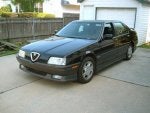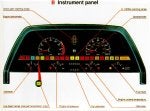Here’s my personal take on buying a 164S. While not totally comprehensive, hopefully it provides future 164 owners the benefit of my experience, at least. I have my car now for several months and have been working through many of the common faults to 164s and fixing the buffoonery of previous owners.
Although I had owned two (and still own one) 70’s era Spiders, I decided to take the plunge into a modern Alfa . . . a ’91 164S. I wanted the S model due to more powerful engine, the look of the car, and performance. I liked the seats better than the L models, as well. Some people think the ground affects skirts and spoiler are tacky looking, but I like them.
When I went shopping, I set my criteria on:
1. Excellent body and paint. Either Black/black or Red/black on the color. From what I had seen, the tan interiors seem to appear to wear worse than the black.
2. No major heavy mechanical problems. The car was going to be located where I didn’t have a garage to work in, therefore any maintenance had to be driveway do-able.
With that in mind, I looked for about six months at various cars on eBay and Craigslist. The really good ones got snapped up very fast, while the ones with big problems languished for sale. Prices were all over the map. From $4500 to $7000 in reasonably similar condition. Although the $4500 one advertised was simply a stunning bargain.
That said, keep in mind that you’re not going to find a perfect one. These cars are 20 years old now. So, when looking at a car, you have a right to expect the seller to be up front and honest about what doesn’t work and the maintenance history. You shouldn’t get a lot of “I don’t knows” when asking questions. On the other hand he doesn’t need you to pick apart every dirty nut and bolt. Armed with some knowledge of common failure items and their costs, you can make a reasonable assessment of what the total cost of the car will be, and make an offer accordingly. Make no mistake. These are not inexpensive cars to restore or maintain, especially if you pay someone else to do it.
The car I bought had:
Good things:
1. Outstanding body, paint, and interior. Like new, really. Only the instrument hood needed recovering.
2. Good tight suspension, Sport shocks that worked, good steering, no leaks anywhere in the car.
3. Solid engine, fresh timing belt, tensioner, water pump. Good clutch and transmission.
4. Only 64k miles, verified by Carfax.
5. Serviceable tires
Bad things:
1. Stepper motors inoperative (fixed now, rebuilt stepper with salvaged gears ($40) from two BMW stepper motors, a $10 drum reinforcement ring, and 6 hours of work // new part is over $300). Turns out, the distribution drum was broken as well and I had to fabricate a replacement piece.
2. Fuel smell when the left front window was open. Bad rubber elbow on fuel tank vent system in trunk. ($5 fix) (parts store common 15mm/9/16" I.D. heater hose 90 deg elbow, 3" on a side)
3. A birds nest of wiring from an aftermarket alarm system and stereo system, neither of which worked. A cabinet in the trunk that covered the fuel pump & sending unit access. (4 afternoons of my time to remove it all)
4. OEM spare doughnut instead of full sized spare. ($50 salvage wheel + $90 tire)
5. Oil pressure sending unit was not giving accurate indications. ($30 fix using better aftermarket sender unit)
6. Airbag light was on. Code was for a bad connection somewhere. ($30 fix with salvage airbag)
7. Front brakes and rotors needed replacing. ($150 for parts and a 2 hours work)
8. Cruise Control inop. (Maladjusted brake & clutch disconnect switches. zero cost to correct)
9. Shifter bushing (reaction rod) worn. ($15 part, but hard to install)
In short here is the Executive Summary of my buying recommendations:
1. “Owned and maintained by an Alfa mechanic” doesn’t necessarily mean squat.
2. Get the Carfax on the car before you go see it. I looked at one car before I got the Carfax. After I agreed to buy it (based on the sellers affirmation that the Carfax was clean) and before money changed hands, I ran a Carfax and found a 50k discrepancy in the mileage. Deal off.
3. The great cars sell quick. Go early to see it and have cash-in-hand when going to look.
4. Just because the seller owns an Alfa, does not make him necessarily trustworthy.
5. Buy the best body, paint, and interior you can find.
6. A well-maintained mid-mileage 164 is better than a neglected low mileage one.
7. Maintenance documentation shows the seller cared about the car.
8. Beware of sellers “blowing-off” of potentially serious mechanical symptoms such as slipping clutches, poor running engines (“just needs a tuneup”), etc.
9. Inop stepper motors de-value a car significantly. Bad stepper motors may be more than just the steppers themselves. The distribution drum may be broken as well. If bad enough, it cannot be repaired in-situ and must be replaced. And that involves a dash removal . . . very, very expensive to have done and very time consuming. Luckily drums that bad are rare. If you find the broken off piece, it's relatively easy to fix with the Alfa-approved brass reinforcement ring fix once the dash is pulled back (not as hard as it sounds, just an afternoon of your time). Keep in mind that bad steppers do not prevent the heater and A/C from working, you just lose control of which vent the air blows out of. If the drum pivot is broken, it usually gravity rotates to the defrost position, which is probably the best place to break anyway.
Although I had owned two (and still own one) 70’s era Spiders, I decided to take the plunge into a modern Alfa . . . a ’91 164S. I wanted the S model due to more powerful engine, the look of the car, and performance. I liked the seats better than the L models, as well. Some people think the ground affects skirts and spoiler are tacky looking, but I like them.
When I went shopping, I set my criteria on:
1. Excellent body and paint. Either Black/black or Red/black on the color. From what I had seen, the tan interiors seem to appear to wear worse than the black.
2. No major heavy mechanical problems. The car was going to be located where I didn’t have a garage to work in, therefore any maintenance had to be driveway do-able.
With that in mind, I looked for about six months at various cars on eBay and Craigslist. The really good ones got snapped up very fast, while the ones with big problems languished for sale. Prices were all over the map. From $4500 to $7000 in reasonably similar condition. Although the $4500 one advertised was simply a stunning bargain.
That said, keep in mind that you’re not going to find a perfect one. These cars are 20 years old now. So, when looking at a car, you have a right to expect the seller to be up front and honest about what doesn’t work and the maintenance history. You shouldn’t get a lot of “I don’t knows” when asking questions. On the other hand he doesn’t need you to pick apart every dirty nut and bolt. Armed with some knowledge of common failure items and their costs, you can make a reasonable assessment of what the total cost of the car will be, and make an offer accordingly. Make no mistake. These are not inexpensive cars to restore or maintain, especially if you pay someone else to do it.
The car I bought had:
Good things:
1. Outstanding body, paint, and interior. Like new, really. Only the instrument hood needed recovering.
2. Good tight suspension, Sport shocks that worked, good steering, no leaks anywhere in the car.
3. Solid engine, fresh timing belt, tensioner, water pump. Good clutch and transmission.
4. Only 64k miles, verified by Carfax.
5. Serviceable tires
Bad things:
1. Stepper motors inoperative (fixed now, rebuilt stepper with salvaged gears ($40) from two BMW stepper motors, a $10 drum reinforcement ring, and 6 hours of work // new part is over $300). Turns out, the distribution drum was broken as well and I had to fabricate a replacement piece.
2. Fuel smell when the left front window was open. Bad rubber elbow on fuel tank vent system in trunk. ($5 fix) (parts store common 15mm/9/16" I.D. heater hose 90 deg elbow, 3" on a side)
3. A birds nest of wiring from an aftermarket alarm system and stereo system, neither of which worked. A cabinet in the trunk that covered the fuel pump & sending unit access. (4 afternoons of my time to remove it all)
4. OEM spare doughnut instead of full sized spare. ($50 salvage wheel + $90 tire)
5. Oil pressure sending unit was not giving accurate indications. ($30 fix using better aftermarket sender unit)
6. Airbag light was on. Code was for a bad connection somewhere. ($30 fix with salvage airbag)
7. Front brakes and rotors needed replacing. ($150 for parts and a 2 hours work)
8. Cruise Control inop. (Maladjusted brake & clutch disconnect switches. zero cost to correct)
9. Shifter bushing (reaction rod) worn. ($15 part, but hard to install)
In short here is the Executive Summary of my buying recommendations:
1. “Owned and maintained by an Alfa mechanic” doesn’t necessarily mean squat.
2. Get the Carfax on the car before you go see it. I looked at one car before I got the Carfax. After I agreed to buy it (based on the sellers affirmation that the Carfax was clean) and before money changed hands, I ran a Carfax and found a 50k discrepancy in the mileage. Deal off.
3. The great cars sell quick. Go early to see it and have cash-in-hand when going to look.
4. Just because the seller owns an Alfa, does not make him necessarily trustworthy.
5. Buy the best body, paint, and interior you can find.
6. A well-maintained mid-mileage 164 is better than a neglected low mileage one.
7. Maintenance documentation shows the seller cared about the car.
8. Beware of sellers “blowing-off” of potentially serious mechanical symptoms such as slipping clutches, poor running engines (“just needs a tuneup”), etc.
9. Inop stepper motors de-value a car significantly. Bad stepper motors may be more than just the steppers themselves. The distribution drum may be broken as well. If bad enough, it cannot be repaired in-situ and must be replaced. And that involves a dash removal . . . very, very expensive to have done and very time consuming. Luckily drums that bad are rare. If you find the broken off piece, it's relatively easy to fix with the Alfa-approved brass reinforcement ring fix once the dash is pulled back (not as hard as it sounds, just an afternoon of your time). Keep in mind that bad steppers do not prevent the heater and A/C from working, you just lose control of which vent the air blows out of. If the drum pivot is broken, it usually gravity rotates to the defrost position, which is probably the best place to break anyway.









